A cooled turbine airfoil performance prediction method with two-dimensional CFD computation and loss models
IF 0.9
4区 工程技术
Q4 ENGINEERING, AEROSPACE
引用次数: 0
Abstract
Abstract The role of turbine blade cooling and coolants are significant factors in modern gas turbine aerodynamic design. This paper presents an effective and rapid airfoil design method based on CFD computation of the S1 surface and the existing loss correlations. The method can assess the coolant mixing loss by identifying each cooling hole separately and obtain the overall mainflow aerodynamic loss for cooled airfoil. The CFD computation code of the S1 surface is powered by a two-dimensional Euler equation, which is inviscid. Typical Kacker–Okapuu empirical correlations are then used to assess the airfoil friction loss, trailing edge loss, and shock loss. A novel form of the Hartsel model for coolant mixing loss is developed and employed in the CFD codes. In the reformed model, the mixing loss coefficient is directly associated with the blowing ratio and the total pressure/temperature ratio of mainstream-to-coolant, making it more convenient than the original model in the airfoil design process. Based on a transonic turbine vane airfoil, the influences of the film outflow location and outflow Mach number on the coolant mixing loss are investigated using the above prediction method and the cascade blowing test.基于二维CFD计算和损失模型的冷却涡轮翼型性能预测方法
涡轮叶片冷却和冷却剂的作用是现代燃气轮机气动设计中的重要因素。本文提出了一种基于S1曲面CFD计算和现有损失关联的高效快速翼型设计方法。该方法可以通过单独识别每个冷却孔来评估冷却剂的混合损失,从而获得冷却后翼型的总体主流气动损失。S1曲面的CFD计算代码由二维无粘欧拉方程驱动。典型的Kacker-Okapuu经验相关性,然后用来评估翼型摩擦损失,后缘损失和冲击损失。提出了一种新的计算冷却剂混合损失的Hartsel模型,并将其应用于CFD计算规范中。在改进模型中,混合损失系数与吹气比和主流与冷却剂的总压/温度比直接相关,使得其在翼型设计过程中比原模型更加方便。以某跨声速涡轮叶片翼型为研究对象,采用上述预测方法和叶栅吹气试验,研究了膜出口位置和出口马赫数对冷却剂混合损失的影响。
本文章由计算机程序翻译,如有差异,请以英文原文为准。
求助全文
约1分钟内获得全文
求助全文
来源期刊

International Journal of Turbo & Jet-Engines
工程技术-工程:宇航
CiteScore
1.90
自引率
11.10%
发文量
36
审稿时长
6 months
期刊介绍:
The Main aim and scope of this Journal is to help improve each separate components R&D and superimpose separated results to get integrated systems by striving to reach the overall advanced design and benefits by integrating: (a) Physics, Aero, and Stealth Thermodynamics in simulations by flying unmanned or manned prototypes supported by integrated Computer Simulations based on: (b) Component R&D of: (i) Turbo and Jet-Engines, (ii) Airframe, (iii) Helmet-Aiming-Systems and Ammunition based on: (c) Anticipated New Programs Missions based on (d) IMPROVED RELIABILITY, DURABILITY, ECONOMICS, TACTICS, STRATEGIES and EDUCATION in both the civil and military domains of Turbo and Jet Engines.
The International Journal of Turbo & Jet Engines is devoted to cutting edge research in theory and design of propagation of jet aircraft. It serves as an international publication organ for new ideas, insights and results from industry and academic research on thermodynamics, combustion, behavior of related materials at high temperatures, turbine and engine design, thrust vectoring and flight control as well as energy and environmental issues.
 求助内容:
求助内容: 应助结果提醒方式:
应助结果提醒方式:


